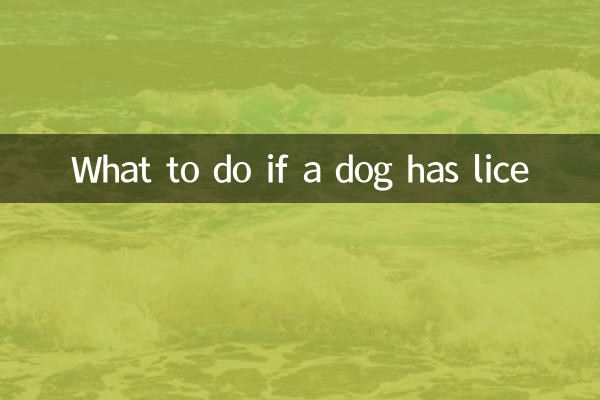What should I do if a dog has lice? Comprehensive analysis of prevention and control methods and hot topics
Recently, pet health issues have become one of the hot topics on the Internet, especially the prevention and treatment methods for dogs to grow lice, which has attracted the attention of a large number of pet owners. This article will combine popular topics and hot content in the past 10 days to provide you with a structured solution to help you easily deal with the problem of lice in dogs.
1. Common symptoms of lice in dogs

Lice are common ectopic parasites in dogs. They not only make the dog feel itchy, but may also cause skin infections or other health problems. Here are the typical symptoms of lice in dogs:
| symptom | describe |
|---|---|
| Frequent scratching | Dogs constantly scratch their body due to itching, especially their ears, neck and other parts |
| Red and swollen skin | Lice bites can cause redness, swelling, and even small wounds |
| Hair loss | Local hair is sparse or fallen off, and in severe cases, alopecia areata may occur |
| Lice or insect eggs can be seen | Small black or white dots found at the roots of hair or on the surface of the skin |
2. Analysis of the reasons why dogs have lice
According to recent hot discussions, the main reasons for dogs to have lice include the following:
| reason | Percentage | Solution |
|---|---|---|
| The environment is unclean | 35% | Regularly clean the living environment of dogs, including nest pads, toys, etc. |
| Contact with other animals | 30% | Avoid contact with stray animals or undewormed pets |
| Not regularly deworming | 25% | Use external deworming drugs every month, such as drops or sprays |
| Low immunity | 10% | Strengthen nutrition and improve dog immunity |
3. Prevention and treatment of lice in dogs
Combining popular topics across the network and veterinary advice, the following are effective prevention and treatment measures:
1. Drug treatment
There are a variety of drugs for lice on the market, including drops, sprays, oral medicines, etc. Please consult your veterinarian before use and choose a product that suits the age and weight of the dog.
2. Clean the environment
Lice not only live on dogs, but also hide in the environment. Thoroughly clean the dog's nest pads and toys and treat them with high temperature or special disinfectant.
3. Physical lice removal
Use a fine-toothed comb to comb your dog's hair to remove some lice and eggs. After combing, soak the comb in soapy water to kill the lice.
4. Natural Remedies
Some pet owners prefer natural methods, such as apple cider vinegar dilution spray or tea tree essential oil (use with caution, some dogs may be allergic to them).
4. Recent hot topics and user questions
| Hot Topics | Discussion hot topic | Expert advice |
|---|---|---|
| Safety of dog deworming medicine | high | Choose a regular brand and use it strictly according to the instructions |
| Will lice spread to people | middle | Lice are generally not contagious, but hygiene is required |
| Special precautions for puppies to remove lice | high | Use puppies with accurate dosage |
| Daily measures to prevent lice | Extremely high | Regular deworming, keep the environment clean, and strengthen nutrition |
5. Prevention is better than treatment
Preventing lice from dogs is more important than treatment. Here are the precautions:
1. Regular use of external deworming drugs every month
2. Avoid dogs from animals that may carry parasites
3. Keep the dog's living environment clean and hygienic
4. Regularly groom your dog's hair check
5. Strengthen dog nutrition and improve immunity
6. When do you need medical treatment?
If the following situations occur, it is recommended to take your dog to medical treatment immediately:
1. No improvement in symptoms after 3 days of home treatment
2. Severe skin infection in dogs
3. The number of lice is too large and difficult to control
4. Dogs exhibit abnormal behavior or loss of appetite
Through the above comprehensive analysis and solutions, I believe you can effectively deal with the problem of lice in dogs. Remember that timely prevention and correct treatment are the key to ensuring dog health.

check the details

check the details